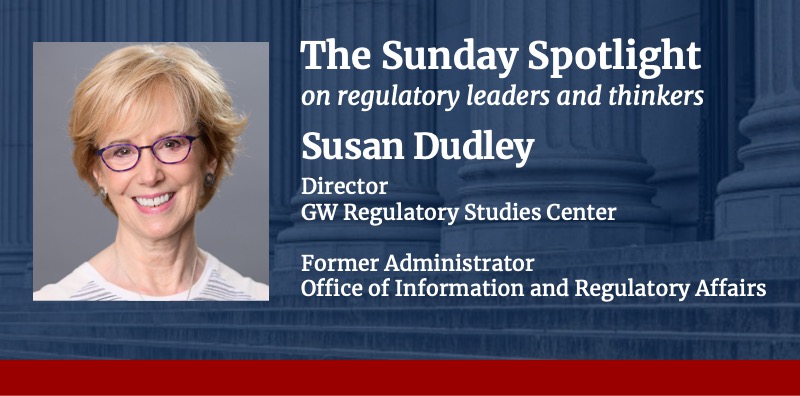
Susan Dudley, former OIRA Administrator, discusses proposed changes to federal guidelines for regulatory impact analysis.
In a discussion with The Regulatory Review, former Administrator of the Office of Information and Regulatory Affairs (OIRA) Susan Dudley offers her thoughts about important guidelines federal agencies use to analyze new regulations before they adopt them.
The Biden Administration recently proposed making changes to these guidelines by releasing a draft revision of Circular A-4, a document originally issued twenty years ago to this day by the Office of Management and Budget (OMB) but which has not been updated since. Dudley analyzes the role that the existing Circular A-4 has played in assessing regulatory impacts, shares her views about the significance of the proposed changes, and offers suggestions on how to improve Circular A-4.
Dudley views economic analysis as an important ingredient in the development of efficient regulation. She supports the proposal to change Circular A-4 to emphasize the need for more information about regulations’ distributional consequences, especially when regulations would impose significant costs on low-income individuals. Dudley suggests that OMB should further revise its proposed Circular by limiting agencies’ ability to use paternalism to justify new regulations and by providing more objective principles for producing cost-benefit estimates.
Dudley spent her early career as an economist for various agencies, including the Commodity Futures Trading Commission, Environmental Protection Agency, and OIRA. She served as OIRA Administrator within the Bush Administration from 2007-2009. At the end of her service as Administrator, Dudley established the George Washington University Regulatory Studies Center and has remained its director since. She is also a distinguished professor of practice in the Trachtenberg School of Public Policy and Public Administration at George Washington University. In addition, she is a past president of the Society for Benefit Cost Analysis and a senior fellow with the Administrative Conference of the United States.
The Regulatory Review is pleased to share the following interview with Susan Dudley.
TRR: What role does Circular A-4 play in agencies’ regulatory analyses? How does it affect decisions made by agencies and OIRA during the rulemaking process?
Circular A-4 is the blueprint for estimating the impacts—positive and negative—of available regulatory approaches to addressing an identified public need. Ideally, agencies conduct regulatory impact analysis at the beginning of the regulatory process to determine if a regulation is needed and what approaches will yield the greatest net social benefits.
Regulatory impact analysis informs policy decisions; it does not determine them. It applies an economic lens to examine the welfare differences among alternative policies, which policymakers consider along with other factors, such as legal constraints, political viability, distributional impacts, and practicality.
TRR: Why has it taken 20 years before an administration proposed updates to Circular A-4?
Since the Circular is grounded in core economic principles and policy analysis practices, it hasn’t required frequent updates to remain relevant and useful. It provides structure for agencies in complying with Executive Order 12,866—issued by President Clinton in 1993 and still in effect today. The Executive Order and Circular A-4 have proven durable across different presidential administrations because they are based on objective principles that help agencies provide nonpartisan information to policymakers on an important factor in policy decisions—the efficiency of different approaches to achieving policy goals.
TRR: What aspects of the revisions proposed by the Biden Administration do you support?
The draft Circular includes a substantive section on assessing the distributional consequences of regulatory alternatives—who bears the costs, and who receives the benefits. The 2003 Circular contains a very brief discussion of distributional effects, and I think additional detail is overdue. Disaggregating effects on lower-income households is particularly important for regulations that increase the costs of basic goods and services, like food or energy, or that disproportionately affect disadvantaged segments of society. However, in a public comment I submitted to OMB, I raised serious concerns about the proposed use of numerical “weights” to count a dollar as more or less than a dollar depending on the affected party. As former presidents of the Society for Benefit-Cost Analysis wrote to OIRA, there are no widely accepted principles, nor is there professional consensus, to support embedding non-transparent normative factors into agencies’ benefit and cost estimates.
TRR: What parts of the proposed revisions do you think need further refinement or a return to the original?
My comment to OMB noted that the revised draft—which is almost twice the length of the 2003 version—is needlessly complex, likely leading to analyses that are less transparent to policy officials and the public. For all but the most significant regulations, a simpler, more transparent presentation of alternatives with clear acknowledgment of uncertainties and their impact on projections, would be more valuable. Specifically, I think OMB should:
- Require agencies to present best available estimates of likely benefits and costs and avoid incorporating normative methods and factors in the quantitative analysis (such as with weighting);
- Avoid unjustified precision in estimates (such as the proposed discount rate of 1.7 percent) and urge agencies to present ranges and best estimates;
- Provide less leeway either to override state, local, territorial, or tribal actions or to regulate individuals based on paternalistic assumptions that people do not act in their own interest; and
- Require agencies to present data on domestic impacts separately from global impacts.
TRR: Beyond updating Circular A-4, what steps can the federal government take to strengthen regulatory analysis and improve regulation?
The draft Circular does not mention retrospective evaluation of regulatory impacts. This is a missed opportunity to provide agencies guidance on implementing President Obama’s pivotal Executive Order 13563—which President Biden reaffirmed on his first day in office. There is bipartisan support for ex-post regulatory analysis and my comment to OMB suggested that the guidelines encourage agencies to adopt a learning agenda when developing a new regulation to improve the available evidence for meaningful retrospective evaluation. This could include designing rules with subsequent evaluation in mind. That might mean identifying when it would be beneficial to gather more information by focusing on assumptions to which outcomes are most sensitive. And it could also mean writing rules that provide opportunities for natural experiments, including by allowing state, local, and tribal governments to take the lead on regulations.
The Sunday Spotlight is a recurring feature of The Regulatory Review that periodically shares conversations with leaders and thinkers in the field of regulation and, in doing so, shines a light on important regulatory topics and ideas.



